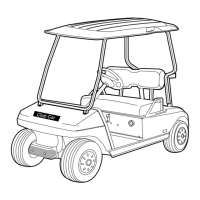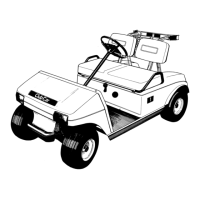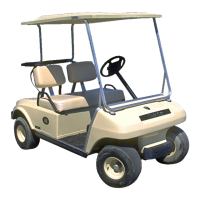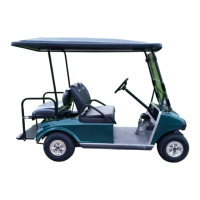
Do you have a question about the Club Car Gasoline DS Golf Car 2000 and is the answer not in the manual?
| Brand | Club Car |
|---|---|
| Model | Gasoline DS Golf Car 2000 |
| Category | Offroad Vehicle |
| Language | English |
Explains crankcase and exhaust emission control systems compliance.
Details on unleaded gasoline, octane rating, and oxygenated fuels.
Highlights maintenance, warranty, and prohibited acts for emission control.
Recommends API Classification for engine oils.
Provides oil viscosity recommendations based on temperature.
Details warranty coverage, limitations, and registration requirements.
States liability for manual errors, copyright, and vehicle limitations.
Confirms conformance to safety standards and notes design change rights.
Details limited warranties for frame, engine, powertrain, and accessories.
Lists exclusions, items that void the warranty, and proper usage.
Outlines how to make a claim, sole remedies, and disclaimers.
Covers consequential damages, contact info, and modification warnings.
Thanks user for choosing Club Car and emphasizes protecting investment.
Urges reading manual for operating instructions and safety procedures.
Highlights customer support system and where to find representatives.
Recommends keeping manual with the vehicle for future owners.
Explains the purpose and impact of safety signs like WARNING.
Urges users to review manual for DANGER, WARNING, CAUTION statements.
Emphasizes understanding safety language to prevent injury or death.
Explains DANGER, WARNING, CAUTION, and NOTE definitions and importance.
Stresses immediate replacement of damaged or unreadable safety decals.
Illustrates safe battery cable removal procedure before servicing.
Highlights dangers of battery/gasoline vapors, carbon monoxide, and storms.
Covers warnings on children, stopping, service, tools, usage, modifications, and frame grounding.
Identifies driver/passenger warnings, controls, and engine-related decals.
Highlights key switches, pedals, and the forward/reverse handle.
Explains how to find the vehicle's serial number.
Recommends appointing a safety committee for fleet operations.
Covers checking parts, decals, tires, engine oil, and fuel level.
Details checks for brakes, park brake, reverse buzzer, steering, accelerator, and governor.
Explains the function and positions of the key switch.
Details the operation of the forward/reverse handle and reverse buzzer.
Explains how the accelerator pedal controls speed and park brake release.
Details how to use the brake and park brake pedals.
Explains the neutral lock-out cam for service and operation modes.
Details choke usage and the function of the oil warning light.
Lists warnings for licensed drivers, occupants, and night use.
Provides instructions for safe driving, including body position and speed on slopes.
Warns against public road use, driving under influence, and specifies trained drivers.
Provides step-by-step instructions for starting and stopping the vehicle.
Details how to park, leave, and secure the vehicle.
Lists warnings for towing on public roads, using approved bars, and speed limits.
Provides warnings for transporting vehicles on trailers on public roads.
Highlights dangers related to gasoline storage and handling.
Warns about battery charging and freezing during storage.
Outlines steps for preparing the vehicle for storage and returning it to service.
Stresses importance of preventive maintenance for performance and avoiding repairs.
Lists warnings for operating, moving parts, hot components, and electrical safety.
Details daily checks for vehicle warning decals, brake system, and steering.
Details monthly service tasks for engine, tires, and general vehicle.
Details semi-annual service tasks for battery, alignment, and brakes.
Details annual service for engine/air intake and two-year service for fuel filters.
Lists lubrication points and recommended lubricants for semi-annual service.
Details lubrication for transaxle/bearings and engine oil/filter change interval.
Lists capacities for engine crankcase, transaxle, and gasoline tank.
Explains how to check oil level and provides oil viscosity recommendations.
Lists dangers associated with fueling, including static electricity and hot engines.
Advises on tank filling, avoiding oxygenated fuels, and storage preparation.
Highlights dangers of battery gases, sparks, acid, ventilation, and charging.
Warns about terminals and details cleaning, tightening, and charging.
Advises using automotive cleaners, avoiding pressure washing, and proper waste disposal.
Notes importance of proper installation and use of accessories.
Warns that tinted windshields and enclosures do not protect from flying objects.
Urges new owners to register their vehicle for contact purposes.
Describes the Fairway Villager as a four-passenger model with optional bag rack.
Details engine, fuel system, governor, ignition, transaxle, and electrical system.
Specifies steering, suspension, brake, frame, and body details.
Lists tire, seating capacity, and fuel tank capacity.
Provides overall length, width, height, wheelbase, ground clearance, and weight.
Lists forward speed, curb clearance circle, and braking distance.
Details limited warranties for frame, engine, powertrain, and accessories for fleet.
Lists items excluded from fleet warranty coverage, such as fuses, filters, and wear items.
Specifies voiding conditions, sole remedies, and claim procedures.
Defines terms and disclaims implied warranties for fleet vehicles.
Covers consequential damages, contact info, and modification warnings for fleet.











